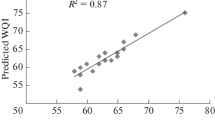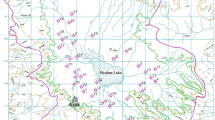Abstract
The assessment of urban water shortage risk is crucial to the development of management strategies that enable a more systematic allocation of water resources and effectively reduce societal losses. The present work proposes a comprehensive approach to the thorough evaluation of water shortage risk in an urban basin. We focus on a case study in Jilin City, demonstrating the suitability of the proposed method. The development and utilization of hydric resources in Jilin City is both evaluated and simulated using the MIKE BASIN model, involving hydrological data from 1956 to 2010. Furthermore, this investigation provides a comparison between measured and analog quantity results during the period 2001–2010, yielding an acceptable average relative error of 4.478 %. Five indicators, namely, hazard rate, restorability, vulnerability, recurrence period, and risk level are investigated with the purpose of organizing the assessment system prior to mapping the level of water shortage risk with the SVM model. The data calculated from both the MIKE BASIN model and the emergency conditions are used to formulate five indicators of water shortage assessment. Finally, the level of water shortage risk is determined for six sub-basins in Jilin City. Several schemes are capable of improving the water supply and alleviating the shortage conditions.










Similar content being viewed by others
References
Benqing R, Yuping H, Hao W et al (2005) Fuzzy comprehensive assessment of water shortage risk. J Hydraul Eng 36(8):906–912
Chen ZQ, Wang SC, Wang YJ (2007) Application of MIKE BASIN to water allocation—taking water allocation in Huaihe river main stream: Tongyang to Bangbu for example. East China seven provinces (municipalities) water conservancy academy 20th, Anhui: Anqing 111–117
Chen P, Zhang JQ, Ji Y, et al (2010) Risk-based theory of risk assessment of urban water resources. In: 4th annual meeting of risk analysis council of china association for disaster prevention, Changchun: (13): 544–548
Christensen FD (2004) Coupling between the river basin management model (MIKE BASIN) and the 3D hydrological model (MIKE SHE) with use of the OpenMI System. In: Hydroinformatics 2004: proceedings of the 6th international conference on hydroinformatics, Singapore, 21–24 June 2004. World Scientific, 126
Cortes C, Vapnik V (1995) Support vector networks. Mach Learn 20:273–297
Cristianini N, Taylor S (2000) An information to support vector machines and other kernel-based learning methods. Cambridge University Press, New York
DHI Water and Environment (2003) MIKE BASIN-Short Introduction and Tutorial
Feng LH, Huang CF (2008) A risk assessment model of water shortage based on information diffusion technology and its application in analyzing carrying capacity of water resources. Water Resour Manag 22:621–633
Gu WQ, Shao DG, Jiang YF (2012) Risk evaluation of water shortage in source area of middle route project for south-to-north water transfer in China. Water Resour Manag 26:3479–3493
Ireson A, Makropoulos C, Maksimovic C (2006) Water resources modelling under data scarcity: coupling MIKE BASIN and ASM groundwater model. Water Resour Manag 20(4):567–590
Jonsdottir H, Eliasson J, Madsen H (2005) Assessment of serious water shortage in the Icelandic water resource system. Phys Chem Earth 30:420–425
Lv Y, Huang GH, Sun W (2013) A solution to the water resources crisis in wetlands: development of a scenario-based modeling approach with uncertain features. Sci Total Environ 442:515–526
Manoj KJ, Ashim DG (2003) Application of MIKE BASIN for water management strategies in a Watershed. Water Int 28(1):27–35
Maria A, Loise S (2003) River basin management in Namibia. Phys Chem Earth 28:1054–1062
Marks DH (1971) A new method for the realtime operation of reservoir system. Water Resour Res 23(7):1376–1390
McKinney DC, Cai X (2002) Linking GIS and water resources management models: an object-oriented method. Environ Model Softw 17(5):413–425
Mo K (2008) Application of MIKE BASIN for water resources study of Daling river basin in WRDMAP. Water Sci Eng Technol 5:16–19 (in Chinese)
Nicolosi V, Cancelliere A, Rossi G (2009) Reducing risk of shortage due to drought in water supply system using genetic algorithms. Irrig Drain 58:171–188
Nieto PJG, Fernández JRA, Suárez VMG et al (2015) A hybrid PSO optimized SVM-based method for predicting of the cyanotoxin content from experiment cyanobacteria concentrations in the Trasona Reservior: a case study in Northern Spain. Appl Math Comput 260:170–187
Rao Z, Debski D, Webb D, Harbin R (2010) Genetic algorithm-based optimization of water resources allocation under drought conditions. Water Sci Technol: Water Supply 10(4):517–525
Rubab FB, Ana P, Micheal H et al (2012) Water allocation assessment in low flow river under data scarce conditions: a study of hydrological simulation in Mediterranean. Sci Total Environ 440:60–71
Safavi HR, Esmikhani M (2013) Conjunctive use of surface water and groundwater: application of a support vector machines (SVMs) and genetic algorithms. Water Resour Manag 27(7):2623–2644
Seyed AJ, Sahar R, Edris S (2012) Environmental risk assessment of gas pipelines by using of indexing system method (case study: transportation pipelines 12 inches, Aabpar–Zanjan of Iran). APCBEE Procedia 3:231–234
Wang WS, Huang WJ, Ding J (2005) Study on the complexity of runoff change based on the dis-noising of wavelet transform and symbolic dynamics. Adv Water Sci 16(3):380–383 (in Chinese)
Xiao ZY, Chen L (2008) Runoff prediction model for Hanjiang river basin based on MIKE BASIN program. J Yangtze River Sci Res Inst 25(6):43–47 (in Chinese)
Yang CC, Yeh CH, Ho CC (2015) Systematic quantitative risk analysis of water shortage mitigation projects considering climate change. Water Resour Manag 29:1067–1081
Acknowledgments
The authors would like to thank the National Natural Science Foundation of China for financially supporting this research under Contracts No. 41072171.
Author information
Authors and Affiliations
Corresponding author
Ethics declarations
Conflict of interest
None.
Rights and permissions
About this article
Cite this article
Zhang, Q., Liang, X., Fang, Z. et al. Urban water resources allocation and shortage risk mapping with support vector machine method. Nat Hazards 81, 1209–1228 (2016). https://doi.org/10.1007/s11069-015-2129-4
Received:
Accepted:
Published:
Issue Date:
DOI: https://doi.org/10.1007/s11069-015-2129-4




